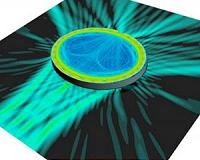 |
Princeton NJ (SPX) Feb 04, 2011 Princeton University engineers have developed a new laser sensing technology that may allow soldiers to detect hidden bombs from a distance and scientists to better measure airborne environmental pollutants and greenhouse gasses. "We are able to send a laser pulse out and get another pulse back from the air itself," said Richard Miles, a professor of mechanical and aerospace engineering at Princeton, the research group leader and co-author on the paper. "The returning beam interacts with the molecules in the air and carries their finger prints." The new technique differs from previous remote laser-sensing methods in that the returning beam of light is not just a reflection or scattering of the outgoing beam. It is an entirely new laser beam generated by oxygen atoms whose electrons have been "excited" to high energy levels. This "air laser" is a much more powerful tool than previously existed for remote measurements of trace amounts of chemicals in the air. The researchers, whose work is funded by the Office of Naval Research's basic research program on Sciences Addressing Asymmetric Explosive Threats, published their new method Jan. 28 in the journal Science. Miles collaborated with three other researchers: Arthur Dogariu, the lead author on the paper, and James Michael of Princeton, and Marlan Scully, a professor with joint appointments at Princeton and Texas A and M University. The new laser sensing method uses an ultraviolet laser pulse that is focused on a tiny patch of air, similar to the way a magnifying glass focuses sunlight into a hot spot. Within this hot spot - a cylinder-shaped region just 1 millimeter long - oxygen atoms become "excited" as their electrons get pumped up to high energy levels. When the pulse ends, the electrons fall back down and emit infrared light. Some of this light travels along the length of the excited cylinder region and, as it does so, it stimulates more electrons to fall, amplifying and organizing the light into a coherent laser beam aimed right back at the original laser. Researchers plan to use a sensor to receive the returning beam and determine what contaminants it encountered on the way back. "In general, when you want to determine if there are contaminants in the air you need to collect a sample of that air and test it," Miles said. "But with remote sensing you don't need to do that. If there's a bomb buried on the road ahead of you, you'd like to detect it by sampling the surrounding air, much like bomb-sniffing dogs can do, except from far away. That way you're out of the blast zone if it explodes. It's the same thing with hazardous gases - you don't want to be there yourself. Greenhouse gases and pollutants are up in the atmosphere, so sampling is difficult." The most commonly used remote laser-sensing method, LIDAR - short for light detection and ranging - measures the scattering of a beam of light as it reflects off a distant object and returns back to a sensor. It is commonly used for measuring the density of clouds and pollution in the air, but can't determine the actual identity of the particles or gases. Variants of this approach can identify contaminants, but are not sensitive enough to detect trace amounts and cannot determine the location of the gases with much accuracy. The returning beam is thousands of times stronger in the method developed by the Princeton researchers, which should allow them to determine not just how many contaminants are in the air but also the identity and location of those contaminants. The stronger signal should also allow for detection of much smaller concentrations of airborne contaminants, a particular concern when trying to detect trace amounts of explosive vapors. Any chemical explosive emits various gases depending on its ingredients, but for many explosives the amount of gas is miniscule. While the researchers are developing the underlying methods rather than deployable detectors, they envision a device that is small enough to be mounted on, for example, a tank and used to scan a roadway for bombs. So far, the researchers have demonstrated the process in the laboratory over a distance of about a foot and a half. In the future they plan to increase the distance over which the beams travel, which they note is a straightforward matter of focusing the beam farther way. They also plan to fine-tune the sensitivity of the technique to identify small amounts of airborne contaminants. In addition, the research group is developing other approaches to remote detection involving a combination of lasers and radar. "We'd like to be able to detect contaminants that are below a few parts per billion of the air molecules," Miles said. "That's an incredibly small number of molecules to find among the huge number of benign air molecules."
Share This Article With Planet Earth
Related Links Princeton University, Engineering School Space Technology News - Applications and Research
 Capasso Lab Demonstrates Highly Unidirectional Whispering Gallery Microlasers
Capasso Lab Demonstrates Highly Unidirectional Whispering Gallery MicrolasersCambridge, MA (SPX) Dec 14, 2010 Utilizing a century-old phenomenon discovered in St. Paul's Cathedral, London, applied scientists at Harvard University have demonstrated, for the first time, highly collimated unidirectional microlasers. The result of a collaboration with researchers from Hamamatsu Photonics in Hamamatsu City, Japan, and the Institute of Theoretical Physics of the University of Magdeburg, Germany, the adv ... read more |
|
| The content herein, unless otherwise known to be public domain, are Copyright 1995-2010 - SpaceDaily. AFP and UPI Wire Stories are copyright Agence France-Presse and United Press International. ESA Portal Reports are copyright European Space Agency. All NASA sourced material is public domain. Additional copyrights may apply in whole or part to other bona fide parties. Advertising does not imply endorsement,agreement or approval of any opinions, statements or information provided by SpaceDaily on any Web page published or hosted by SpaceDaily. Privacy Statement |